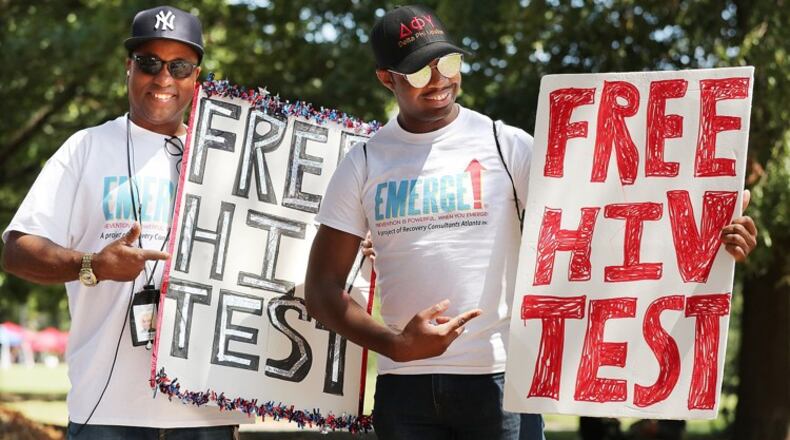Editor’s note: This story was originally published Aug. 23, and updated Sept. 7 to reflect the official release of the study by GLAAD
While knowledge and treatment around HIV continues to improve, HIV stigma remains an issue surrounding the disease and the people who live with it, according to a report released Wednesday.
Despite increasing treatment and prevention options, the report found that almost 90% of Americans believe that HIV stigma still exists. The stigma can manifest in how people negatively talk about HIV, how people treat individuals living with HIV differently and the isolation of people living with HIV.
Meanwhile, the higher incidence of HIV in the South is driven by factors such as poverty, lack of access to care and cultural factors that act as barriers to receiving culturally competent care around the disease. HIV stigma influences the social factors.
Masonia Traylor, a Decatur resident, has experienced this stigma firsthand.
“It feels like all of the things that puts a person at the bottom of a totem pole,” she said. “I often tell people that HIV is violent. It is cruel. It is mean. It is disrespectful in all facets because it tries to destroy and it causes human beings to be cruel, mean, disrespectful and unkind.”
Traylor is an HIV activist who has been living through the stigma since her diagnosis in 2010. She now devotes her time as an activist spreading HIV awareness amongst youth and Black women.
GLAAD, a non-profit organization focused on LGBTQ advocacy, representation in media and cultural change, released its 2023 State of HIV Stigma Report Wednesday, the fourth annual report on the issue. The report was produced in partnership with Gilead Sciences, a pharmaceutical company that makes HIV treatment and prevention medications. The Atlanta Journal-Constitution was given an early look at the report, which was created to answer questions about attitudes, knowledge and stigma around HIV and people living with HIV.
HIV stigma is negative attitudes and beliefs about people with HIV, according to the Centers for Disease Control and Prevention. From stigma comes discrimination, as behaviors influence attitudes and beliefs. Much of HIV stigma is a result of fear caused by misinformation circulated during the early days of the epidemic in the 1980s. Talking openly to challenge the misinformation around HIV can demystify the many myths that continue to exist around the disease and help to reduce stigma.
The report’s findings come from a national online survey of 2,533 Americans 18 years and older. Of the respondents, 2,076 were non-LGBTQ. The survey’s findings were weighted to represent the adult population of the U.S.
According to GLAAD President and CEO Sarah Kate Ellis, the South has some of the highest levels of discomfort when it comes to HIV, but it also has the highest rates of new HIV diagnoses. Discomfort in interacting with barbers, hairstylists, teachers and co-workers living with HIV each increased slightly from 2022 to 2023, as highlighted in the report.
“I think they are interconnected and there is a continued misinformation campaign around the LGBTQ community. Part of that includes HIV and stigmatizing the LGBTQ community,” Ellis said. “I think that we see that even more in the U.S. South.”
In 2021, the South accounted for more than half (52%) of new HIV diagnoses in the U.S. despite only making up 38% of the population, according to the CDC.
One common misconception about HIV is that the disease only occurs in particular groups, such as the LGBTQ community. This idea results in fewer people getting tested for HIV in their lifetime. GLAAD’s report found that 65% of Americans believe that everyone should get tested for HIV in their lifetime. Still, 37% of Americans believe that HIV mostly impacts LGBTQ people. However, anyone can contract HIV, regardless of sexual orientation and gender identity.
“It surprises me that people still don’t know the basics about HIV 40 years in,” Humberto Orozco, a clinical research coordinator at Emory School of Medicine and president of Latino LinQ, a nonprofit organization that promotes equity for LGBTQ Latinx individuals, said. “HIV is not a threat like it used to be. The misinformation that’s out there about HIV being a death sentence still surprises me.” Orozco was diagnosed with HIV at 19 and has been living with the disease for 15 years.
Additionally, 80% of Americans believe people living with HIV should be charged with a crime for not disclosing their HIV status when having sex with someone who does not have HIV.
“One of the main things when we think about the criminalization of HIV is that these laws are antiquated and just do not follow science,” Darwin Thompson, director of public affairs and corporate giving for Gilead, told The Atlanta Journal-Constitution. “These laws were created out of fear during the early part of the epidemic, and they have not caught up with the science. We need to do a better job at engaging our local elected officials and politicians to ensure that laws are caught up within the current scientific advancement when it comes to HIV.”
The intergenerational knowledge gaps around HIV that exist were also highlighted. According to the report, 64% of Gen X (people born from 1965-1980) are knowledgeable about HIV, compared to 34% of Gen Z (people born from 1997-2012). In 2020, 57% of new HIV diagnoses were in people ages 13 to 34, which includes Millennials and Gen Z.
“Unfortunately, we are seeing less awareness in the generation that could end HIV, which is Gen Z,” said Ellis. “We have these big bold dreams of an HIV-free generation, and it’s still possible. There’s a lot of education and information and we need to shorten the knowledge gap that exists with Gen Z.”
Ellis went on to say that because Gen Z did not grow up during the HIV epidemic, there are myths around the disease for people within this age group. She and Thompson also acknowledged the need to fill in the critical knowledge gaps between generations around HIV.
“There has been an ongoing intergenerational disconnect,” said Traylor. “Four generations in one household can have HIV, and neither would know it.”
While the report pointed out some dismaying statistics, Ellis noted other noteworthy improvements around HIV stigma. Awareness around medications that exist to prevent and treat HIV has increased, with 70% of Americans knowing that these medications according to the report. Additionally, more Americans reported seeing HIV stories in the media this year.
“We have to continue to educate communities around what stigma looks like and how they can use their individual perception and realities to reduce stigma when it comes to HIV,” said Thompson.
The Atlanta Journal-Constitution and Report for America are partnering to add more journalists to cover topics important to our community. Please help us fund this important work at ajc.com/give
About the Author
The Latest
Featured



